Home of the Infantry Regiments of Berkshire and Wiltshire
The Duke of Edinburgh's Royal Regiment
(Berkshire and Wiltshire)
1959 – 1962 Isle of Wight/Tidworth
The name of the Regiment is derived from those of its two parent Regiments; The Royal Berkshire Regiment (Princess Charlotte of Wales's) and the Wiltshire Regiment (Duke of Edinburgh's). The amalgamation parade took place at Albany Barracks, Parkhurst on the Isle of Wight, at which Field Marshall His Royal Highness The Prince Philip, Duke of Edinburgh, KG, KT, GBE, Colonel-in-Chief The Wiltshire Regiment, presented Colours to the 1st Battalion of his new Regiment. Many of the ‘old and bold’ from the former regiments were present.
Number one guard marched onto the parade square at Albany Barracks at the start of the presentation of Colours to the newly formed regiment. The ‘Advance’ was sounded and the guards, under command of their officers, marched on parade to the tune ‘Blue Bonnets’. All of those who took part in the parade wore No. 1 Dress. The march ‘Blue Bonnets o’er the Border’ came from the Wiltshire Regiment which had inherited it from the 99th Foot whose version of the opening lines read: ‘March Past o’er the border, Some of ‘em drunk, and some of ‘em sober’. This tune was to become familiar to generations of soldiers who served in the ranks of 1 DERR.
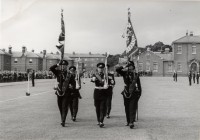
DERR Formation Parade.
The new Colours were removed from the piled drums preparatory to the Colonel-in-Chief, The Duke of Edinburgh, presenting them to the regiment. He made a speech which was answered by the Commanding Officer Lieutenant Colonel G F. Woolnough, MC, in the following terms 'These Colours replace those of the two regiments whose traditions and history we combine on amalgamation. The honours borne on these Colours will be a reminder to us of the duty and the service we inherit from these regiments. That duty and service to our sovereign and to our country we now carry forward in the name of your regiment whose title we are honoured and proud to bear'. [The new Colours carried 36 Battle Honours on the Queen’s Colour, and 27 on the Regimental Colour.] After the Colours were presented the new Battalion marched past in quick-time. This was followed by the advance in Review Order and a Royal Salute. Many of the soldiers on parade were National Servicemen with recent service in Cyprus against EOKA terrorists. At the end of the parade the colour party marched off with the new Colours. The colour party was commanded by the regiment’s first Regimental Sergeant Major, Les Hodges who was also the last RSM of the Royal Berkshire Regiment. These Colours were carried until 1984. They were eventually laid up in Salisbury Cathedral where they can be seen today.
Following the amalgamation parade the Commanding Officer Lieutenant Colonel Woolnough worked hard to get the new Battalion into good shape and the training was intense. In September they took part in Exercise BLUE DIAMOND on Salisbury Plain which was notable for the distances covered on foot. The only concession to modern life was transportation back to camp. In October 1959, the Battalion moved to Tidworth, Hampshire where it formed part of the 1st Guards Brigade which was part of the strategic reserve. Here they took part in the 3rd Division shooting competitions coming third out of eleven in the Major unit’s competition.
NORTH AFRICA 1960
In March 1960, the Brigade flew to Libya on Exercise ‘Starlight’ for a month. This was a major air-portable deployment to exercise and test the United Kingdom’s new concept of worldwide deployment of the Strategic Reserve. The Battalion flew to El Adem in Libya from Lyneham in Britannia aircraft of RAF Transport command. On arrive they concentrated in the Timmi area which was about 70 miles west of Tobruk. During the exercise that followed the Battalion covered nearly 90 miles of desert terrain. (Mostly on foot). The exercise finished at El Gubba, 40 miles south-west of Derna and was excellent for developing team-work and welding the new Battalion into an effective combat unit. After returning to England the Regiment received its first freedom of a town, in this case Windsor. The Battalion later changed to 51 Infantry Brigade where, as part of the Army's Strategic Reserve, it had to be ready to fly to any trouble spot, world wide.
BAHAMAS 1960
In 1960 the Royal Hampshire Regiment was serving in the Caribbean and was under strength. ‘B’ Company under the command of Major Blascheck was dispatched to Nassau in the Bahamas in June to reinforce them. They were based at Oakes Field, Nassau. The Company took their families with them for this deployment but the removal of ‘B’ Company meant that the remainder of the Battalion were no longer part of the Strategic Reserve. During this tour the Company was called upon to assist in the relief operation mounted to cope with the trail of disaster left in the wake of Hurricane ‘Donna’. Four relief parties were mobilised and went to the islands of Ragged, Crooked and Acklins Islands. Their job was to assess the damage and send back technical requirements for rebuilding. They distributed relief rations, help rebuild houses, clear rubble and re-float boats. These groups were deployed for ten days carrying out excellent work. At the end of the emergency the governor thanked all ranks of ‘B’ company for their disaster relief work. The company returned home again in December 1960.
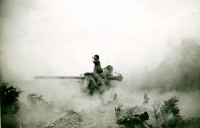
A 106 mm anti-tank gun (known as a BAT) in action when the Battalion was on exercise in Canada in 1961.
CANADA 1961
Because of the rundown of bases overseas and the need to find alternative training grounds for the Army, it was decided that units would make use of land available in Canada. On the 19th June 1961 the Battalion flew out to Canada from RAF Lyneham to Fredericton, New Brunswick, the first ever British unit to do so, to train with units of the Canadian Army in Exercise POND JUMP. The Battalion’s advance party was met by the regimental band of the Black Watch (Royal Highland Regiment) of Canada playing ‘The Farmer’s Boy'. As soon as the Battalion was complete in Canada the training concentration formally began with a military tournament. The teams for this were picked from the nominal rolls of all units by Headquarters 3rd Infantry Brigade Group. It covered all the Infantry skills at the conclusion of which the Battalion won the forced march and physical fitness contests. Much credit was due to the determination of the Battalion’s soldiers who achieved this very shortly after their arrival in Canada. The Battalion made such an impact in Canada that it was referred to as 'The Wonders' because of its high standard of training and ability and in reference to the official title of 1 DERR.
BRITISH GUIANA 1962
Riots and arson broke out in Georgetown, British Guiana. The Battalion was alerted initially to fly out complete as part of Operation WINDSOR 2 to deal with the situation. In the event only ‘A’ company under the command of Major J A Sellers deployed. They left Tidworth on the 17th February 1962, but by the time they arrived the rioting had more or less been brought under control, but the situation in Georgetown remained tense. The rioting (called 'Black Friday') which cost several lives and caused damage that ran into millions of pounds, followed the calling of a general strike in protest against Dr. Cheddar Japan’s austerity budget. The Company deployed four days after the main riot. British action was required because of considerable unease in the USA who were less than keen to have another Cuba on their doorstep. The company came under the control of the 1st Battalion Royal Hampshire Regiment. Over the following weeks they carried out a range of urban internal security tasks and operations. This involved patrols, guards, road blocks and providing stand-by platoons for anti-riot duties. One of the positive sides to this deployment was about 110 local young men asked to join the regiment; later 20 were authorized to join. The company returned to England, April 1962.
The Regiment prepared itself for its next posting in the sun, the Island of Malta.

Drums on Cermonial Duties for the Opening of the Maltese Parliament 1963.
1962 – 1965 Malta
On the 3rd December 1962, the Battalion embarked at Southampton in the ageing troopship, HMT Oxfordshire, for service in Malta. This was an historic occasion as it was the last unit to leave the United Kingdom in a Troopship for service overseas. The journey lasted a week, including in the journey was a stop at Gibraltar to replenish the ship's beer stocks. Before leaving England a set of tiger and panther skins for the Corps of Drums was presented by the High Commissioner for India. This gift was in recognition of The Royal Berkshire and Wiltshire Regiments’ past connections with India. On arrival in Malta the Battalion took up its quarters in St Patrick Barracks and settled down immediately to training on the island. Due to the small size of the island the Battalion was required to train elsewhere, primarily Libya in North Africa. They also trained in Sardinia and in addition carried out many ceremonial parades. They were also required to deploy operationally on the island of Cyprus several times due to the ongoing conflict on the Island.
NORTH AFRICA 1963
The Battalion deployed to Tripolitania, Libya on Exercise DRUM BEAT in August 1963. The advance party opened a moribund Tarhuna Barracks and lines of communication to Tripoli, and then carried out two four day expeditions to Ghadam on the Tunisian border and to Gunza, an old Roman town in the south. This was also preparation for the main body of the Battalion to hit the ground running when they arrived. It was here that the final firepower demonstration of the Vickers medium machine gun took place, organized by Captain RIDLEY. For the first two days of the exercise the companies carried out basic military skills and infantry tactical training. As time progressed the training got harder in terms of distance traversed. The Battalion returned to Malta in October. At the end of this exercise the commanding officer Lt-Col. Boshell said 'It confirmed what I already knew - that the Battalion is extremely fit, and if we had to go into action tomorrow, I would not mind leading this Battalion', which was praise indeed from an officer who fought with the Royal Berkshires in Burma during the Second World War, being awarded the DSO and mentioned in dispatches twice.
In November 1963 three officers and thirty seven soldiers from the 1st Battalion took part in the Tibesti Mountains (North Africa) Expedition. It was commanded by Major Knight with Lieutenant Mackereth as the navigation officer. The expedition was designed to test both men and equipment in harsh desert conditions. They were re-supplied by air and eventually covered a total of 2,700 miles. Over 100 punctures were mended and, apart from major breakdowns, some 150 motor vehicle repairs were carried out. Whilst on this expedition they were informed that the president of the United States, John F. Kennedy had been assassinated. As one member later recalled 'We certainly remembered where we were when Kennedy got shot, being stuck in the desert sticks in my mind'. The team arrived back in Malta on LST Empire Guillemot, returning to St. Patrick’s Barracks, played into barracks behind the band and Corps of Drums led by Drum Major Ford.
In 1964 the Battalion was put on stand-by to go to Cyprus due to the increase in inter-communal violence between the Greek and Turkish Cypriots.
CYPRUS 1964
In early 1964 the Battalion was deployed from Malta to Cyprus on operation ‘QUILT’ as a result of the deteriorating relations between the Turkish and Greek communities. Initially responsible for the defence of Nicosia airport they were later given the task of manning 'The Green Line' in Nicosia itself. The regimental diary recorded that ‘B’ Company 'was to have half the old city based on rather doubtful accommodation in the Armenian Young men's club. The Officer Commanding (OC) [Maj. Graham] returned from the reconnaissance muttering about the squalor, four hour shifts and claustrophobia'. A soldier from ‘B’ Company remembered 'It was the pits'. Although the building was cleaned up most of the platoons spent the bulk of their time deployed on operations in the city. The Battalion’s first task on arriving in Cyprus in February 1964 was to secure the perimeter of Nicosia airfield. The regimental journal recorded 'For many in the company digging-in had a purpose for the first time and holes went down and overhead cover went up in record time'. The Battalion remained until March then went back to Malta. Rifle companies returned to the island over the next eighteen months. Point 'Bravo' on the ‘Green Line’, Nicosia, was manned by soldiers of ‘C’ Company. This was a dangerous area which the company manned for three weeks with the Greek and Turkish irregulars frequently firing at each other. Privates Millar and Brown had a lucky escape during one of these exchanges when a Greek Cypriot firing a light machine-gun nearly hit both of them in Constantine The Great Street. On arrival in Cyprus the drums platoon together with the reconnaissance platoon relieved a platoon of the Gloucestershire Regiment at a particularly troublesome copper mine at Havrovouni. It was here that the Battalion had its first casualty, with Private Clacher being slightly wounded by shotgun pellets discharged by a trigger happy Cypriot. The drums platoon were very much operational soldiers and were used to reinforce undermanned rifle companies. After leaving Nicosia the drums platoon went to the village of Ghaziveran where they remained until the Battalion returned to Malta.
‘C’ Company returned to Cyprus in July 1964, remaining until September. Initially they were under the command of 1 Glosters carrying out operational tasks at Akrotiri, followed by several weeks under the command of the 3rd Battalion Green Jackets (the Rifle Brigade) at Dhekelia.
Back in Malta the remainder of the Battalion spent the rest of the summer on the parade square rehearsing its role as a Guard of Honour in the Independence Day Parade on 21st September 1964. The salute was taken by His Royal Highness, Prince Philip, The Duke of Edinburgh who visited the Battalion during the day. The same guard of honour took part in the main parade that evening at Floriana. The guard consisted of 79 hand picked soldiers under the command of Captain M Draper.

‘B’ Company advancing across the desert on Exercise Sand Beetle’ in Libya in 1964.
NORTH AFRICA 1964 -1965
In November 1964 a total of one hundred men of the Recce Platoon, Assault Pioneer Platoon, ‘B’ companies Support Platoon, the Intelligence Section and an administrative element took part took part in Exercise ‘Early Run’ at Tarhuina Libya., Finally the Battalion deployed as a complete unit in April 1965 on ‘Exercise ‘GUN BLAST’ which took place in Cyrenaica with some very hard training which confirmed the Battalions skills and fitness in operating in a desert scenario.
SARDINIA 1965
On the 14th January 1965 ‘C’ Company set sail from Grand Harbour, Malta in three Royal Navy Minesweepers bound for Sardinia on exercise ‘Olive Grove’ to join Battalion H.Q., HQ Company, together with ‘B’ Company 1st Bn ROYAL SUSSEX REGIMENT for two weeks training. The reason for this was the limited facilities available in Malta. For the Sea journey the Company were divided on board HMS WALKERTON, HMS STUBBINGTON and HMS SHAVINGTON .The navy delivered the Company to San Antioco, an hour’s drive from the Battalions base camp at Cape Teulada. All aspects of training live firing and otherwise were practiced including an Inter – platoon field firing competition where C Company swept the board by capturing the first three places. 2/Lt DALY and his 10 Platoon were first, 9 Platoon second and 11 Platoon third. As they were competing against the Royal Sussex it was agreed to be a satisfying achievement for the company. The Battalion trained hard in Sardinia enduring dreadful weather conditions. They returned to Malta on LST Charles Macleod and LST Empire Gull. On their return to Malta they began preparations for the move to Minden, West Germany as part of the British Army of the Rhine (BAOR).
The attalion’s tour in Malta ended in December 1965 when they flew back to the United Kingdom to spend Christmas on leave prior to re-forming again at Minden in Germany as a Mechanised Battalion of 11th Infantry Brigade.
1965 – 1969 – West Germany
In a very cold February 1966, after three years in sunny Malta, the 1st Battalion re-formed in Minden, West Germany, as a mechanised infantry Battalion in 11 Infantry Brigade – part of the British Army of the Rhine (BAOR). It was stationed in Clifton Barracks, an old Wehrmacht barracks used by the German Army during the Second World War. In 1967 the Battalion took part in exercise 'Hunters Moon' which was held on the Sennelager training area. This exercise was conducted with US and French forces. The exercise scenario was linked directly to the need to maintain a capability to safeguard access to West Berlin. Preparation was the key to success within a mechanised Battalion – a point demonstrated during exercise 'Eternal Triangle' in 1966 where the Battalion did not have a single case of any of its 62 Armoured Personnel Carriers (APC's) having to be sent away for second line repairs, resulting in congratulations from the divisional commander.
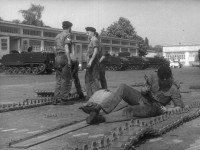
Soldiers working on the tracks of the Armoured Personnel Carriers in the garage area at Clifton Barracks, Minden.
One of the skills required in a mechanised Battalion was the ability to cross rivers in their APC's. The Battalion carried out this training on the river Weser at Hameln. The drivers and commanders had to have a clear understanding of the limitations of their vehicles. A soldier from the Battalion who was a driver at this time remembered 'It was quite hairy, you were trapped in the driver’s compartment attached to all sorts of wires, and received instructions from the commander who stood above you, I was very aware of the water only inches from my face on the other side of the rubber floatation screen'. Having negotiated the river the next task was to exit safely on the far bank. The same soldier remembered that 'After driving into the water you had to pull hard on the tiller so you pulled the vehicle into the flow of the river, then rev the engine as hard as possible, keeping this up until you reached the far bank, remember we were blind and had to act on the commander’s instructions, then the skill was to get both tracks to dig into the far bank simultaneously. If you failed a trip down the river followed. The Battalion soon earned for itself a reputation for efficiency not only within the Brigade but throughout Rhine Army. Apart from training on the vast areas of Sennelager, Soltau and Vogelsang, often with a squadron of the Royal Scots Greys or the 16th/5th Lancers, the Battalion flew out to Libya in February 1967 for five weeks training. In 1968 they moved down to the South of France at Larzac a large training area for company and Battalion training. On the 30th May 1969, as a formal farewell to the town on Minden, the Regimental Band and Corps of Drums marched through the town ‘Beating the Credits, an ancient ceremony dating back to the time when a regiment about to leave a garrison town or base sent its drums and fifes through the streets of the town to let the local traders know that no more credit should be extended to the soldiers of the unit. The Battalions claim to fame was that during its time in Minden of never having to use the low-loader recovery vehicle to bring a Battalion vehicle back from exercise. With that the Battalion moved to England with Catterick as the next posting.
1969 – 1971 Catterick
June 1969 found the Battalion reformed in Alma Barracks Catterick, Yorkshire from where it despatched its Companies world wide. Three Company Groups each of over 180 All Ranks were to go to British Honduras, in Central America, each spending six months there. In addition 'A' Company went off to Malaysia on an exercise, 'B' and 'C' Companies with supporting elements did short tours in Northern Ireland, and, in September 1970, the Battalion less 'C' Company Group, flew out to Canada on another exercise. Finally the whole Battalion was despatched to Northern Ireland in May 1971 for six weeks.
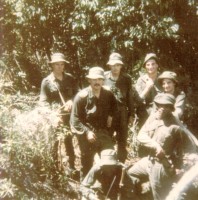
9 Platoon of 'C' Company in British Honduras in 1970.
BRITISH HONDURAS 1969- 1970
In British Honduras the Battalion was responsible during 1969-1970 for the security of the country which was traditionally under threat from its neighbours, the Republic of Guatemala, which regarded the country as one of its provinces. The companies were based in Airport Camp not far from Belize City, but spent a significant amount of time patrolling the border areas. When in barracks at Airport Camp ceremonial events took up part of the time. As well as maintaining their own military skills whilst in British Honduras the companies also trained the local defence forces such as the No. 2 Police Special Force Unit. The police units were in fact para-military, used not only for military duties but also as the riot squads for the colony.
MALAYSIA 1969
‘A’ company went to Malaysia for Exercise SANJAK under the command of Major CB Lea- Cox in August 1969. This was a six week exercise during which the company was based at the Jungle Warfare school at Kota Tinggi, and trained extensively in Johore state. The company took under command a platoon of soldiers from the Singapore Guard Regiment. The exercise provided useful training in air-portability, but also laid a firm foundation of knowledge of jungle operations on which ‘A’ Company was able to draw when its turn came to carry out the British Honduras commitment at the end of December 1969.
CANADA 1970
The Battalion less ‘C’ company went to Canada for Exercise POND JUMP WEST in September 1970 for six weeks. They flew to Edmonton via Gander. They eventually arrived in Camp Wainwright and prepared for a five week training cycle. They started with company training which was linked to working with the supporting arms. This culminated in a Battalion exercise where all the lessons learned were practiced with live firing exercises. The Canadian enemy forces for this part of the exercise had been removed due to operations against a group known as Liberation of Quebec (FLQ)
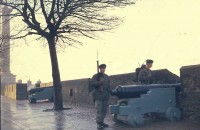

'C' Company Londonderry 1969.
NORTHERN IRELAND
‘C’ Company 1969
The Irish troubles recommenced in August 1969 for the British Army. The one remaining company in Catterick was ‘C’ Company and they together with the drums platoon were ordered to Londonderry at short notice to reinforce the 1st Battalion Queens Regiment. The tour was to last for four months. They were based at the Duncreggan Territorial Army centre and started working to a nine days out and three days in rota. Initially the situation was grim with soldiers sometimes sleeping in the streets. The company was involved in all forms of urban internal security duties and in particular in manning check-points and carrying out foot patrols. They took part in a number of crowd dispersal operations, which included several major riots in the Diamond area of the old city.
‘B’ Company 1970
In June 1970 ‘B’ Company and the Drums together with a troop from 14th Light Regiment, Royal Artillery, were dispatched at short notice to Belfast to reinforce the Royal Scots. The company commander, Maj. Godwin-Austen, later remembered 'On the morning of the 3rd July we conducted Lord Balniel, the Defence Minister, around our company area in an atmosphere of relaxed euphoria and bonhomie. Friendly Irish neighbours gave our patrols tea and sandwiches. By nightfall we were locked in a gun battle with snipers in which at least five civilians were killed and nearly 800 rounds of 7.62 ammunition were fired by British troops'. The violent situation started after a search of a house in Balken Street for arms and ammunition by the Royal Scots and RUC (Royal Ulster Constabulary) in which fifteen pistols, one rifle, a Schmeisser sub-machine gun and a quantity of ammunition and explosives were found. This find sparked off some of the bloodiest rioting that the Province had seen to date. By the end eighteen soldiers were suffering from gunshot and grenade splinter wounds, five civilians died and 300 people were detained, and for the first time an area of Belfast had been placed under military curfew. ‘B’ Company was involved in serious rioting in the Falls Road area of Belfast, in the course of which several men were injured by gelignite bombs. In the operations that followed an officer and two soldiers of the Gloucestershire Regiment were shot and wounded. During this period ‘B’ Coy expended 488 CS cartridges, 64 CS Grenades and several rounds of 7.62mm ball ammunition. Suddenly at the far end of the street a double decker bus appeared. The rioters commandeered it, drove it towards the company and finally placed it across the road about 30 yards in front of them. There was a pause during which they prepared to move forward to the area of the bus. Suddenly without warning, there were a series of shattering bangs in and around them. Soldiers were blown backwards, and they thought they were being grenaded – and they were! All together they had seven bombs thrown at them. With this new development the platoons scattered to a tactical deployment against the walls of buildings. Eight members of 5 Platoon were injured, three having been dragged from the ranks giving a clear indication of the scale of the ferocity. The two most badly injured were Sergeant Potter (later awarded a Queens Commendation) and Private Fern'.
1st Battalion 1971
In 1971 the Battalion was the 'spearhead' Battalion and on stand-by for deployment anywhere in the world to protect British interests. On 22 April that year the Battalion was dispatched to Londonderry, remaining until 28 May. They were based in an empty factory in Drumahoe just outside Londonderry. During the short deployment the Battalion conducted operations in Tyrone, Fermanagh and Antrim, with ‘C’ Company detached for a brief period in the city of Londonderry under the command of the 2nd Parachute Battalion. This tour was relatively peaceful with a few minor finds to their credit. On the 28th May the Battalion returned to Catterick to prepare for its move to Berlin.
Thus the Battalion had an involvement in ‘The Troubles’ from the outset. It was not to be their last. They returned to Catterick on the 28th May , barely two weeks before the first advance party was due to leave for Berlin. The Battalion reformed in Berlin between the 12th – 16th July.
1971 – 1973 – West Berlin
In July 1971 the Battalion moved to Brooke Barracks, Berlin as a Battalion of Berlin Infantry Brigade. During the tour the Battalion took its turn to guard Rudolf Hess in Spandau Prison, to provide the guard on the military train that ran daily between Berlin and Brunswick and to exercise in Schleswig-Holstein and La Courtine, France.
SCHLESWIG-HOLSTEIN 1971
The Battalion deployed on Exercise 'Quickmarch' in Schleswig-Holstein, November-December 1971. This exercise took place to practise different phases of war without the restrictions imposed within the confines of Berlin. A soldier remembered 'That exercise was the coldest I have ever been on; I think they even issued rum. Putting the Nuclear Biological and Chemical (NBC) suits on was normally a bit of a pain, but on this occasion we were grateful for the extra layers to stop freezing to death'. During this exercise the companies were based in villages from five to twenty five miles from Battalion Headquarters. The final exercise covering all phases of war was a Brigade exercise after which the Brigadier expressed his satisfaction with the Battalion.
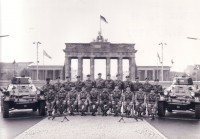
Recce Platoon in front of the Brandenburg Gate, Berlin in 1972.
SPANDAU PRISON
Whilst in Berlin there was an unusual duty location - Spandau Prison guarding the one remaining prisoner, Rudolf Hess. A corporal who took part in this guard duty remembered 'We were warned not to speak to Hess, and that he would attempt to engage the sentries in conversation, after which he would immediately, report the sentry to the guard commander so we kept well clear of him. It was an eerie place with only the one man inside it. Nevertheless it was an interesting duty to carry out’. Cameras were forbidden in the sentry posts, as were cigarettes, but both managed to find their way in. Pte Suchocka later remembered ‘No. 3 post is right opposite his [Hess's] quarters and he comes out every morning and afternoon for one to two hours. He walks round and round wearing paths in the grass, but not sticking to the same route. He will be walking around and then suddenly will break into a high goose-step. Sometimes he just stands below the guard post and stares up at the guard. It drives you mad, we try to ignore him but it is hard.'
In addition to this task the Battalion also had to provide manpower for the ‘Berlin Train Guard, which consisted of six men and one officer.
LA COURTINE 1972
In July 1972 the Battalion deployed to La Courtine, a French training area about half way between Bordeaux and Lyon at the edge of the Massif Central in France, and at a height of about 2,400 feet above sea level. There they carried out field firing and tactical exercises. The training was titled Exercise ‘BEECHNUT’ The Battalion was the first British unit to train there since 1949.
The Battalion’s anti-tank platoon at this time was one of the best in Germany having gained over 15% more hits than any other unit in BAOR in the anti-tank concentration at Putlos. They gave a fire power demonstration to the remainder of the Battalion at the end of the exercise. Before the Battalion left France the Commanding Officer announced that the next posting was as a resident Battalion at Ballykinler in Northern Ireland.
As a result of the Commanding Officers announcement the Battalion raised the tempo of training and exercised at ‘Tin City', Sennelager, West Germany, 1972. The Battalion had moved there from its Berlin station for this intensive period of training, which covered all operational possibilities needed for its forthcoming two year posting to Ballykinler, Northern Ireland.
The Battalion remained in Berlin until July 1973 before returning to Northern Ireland for two years.
1973 – 1975 NORTHERN IRELAND
The Battalion arrived in Ballykinler in July 1973, assuming operational responsibility as the Northern Ireland Province Reserve. The next two years were to be extremely busy with hazards not only confined to the IRA and terrorist action. Accidents involving heavy armoured vehicles on tracks and minor roads that were designed for light traffic were common. In August 1973 ‘C’ Company were deployed to the Bogside area of Londonderry, an area very familiar to the old soldiers of this Company.
BATTLE OF THE HUMP 1974
Barracks for 12 Platoon (Drums), and a section of 10 Platoon, was a location known as 'The Hump' Vehicle Check Point (VCP). This was on the border of the Republic of Ireland near the town of Strabane. At about 06.45 hours on the 22nd February 1974 they came under fire from IRA gunmen located at the Inter Counties Hotel. Just as a soldier identified the firing point the position was hit by two mortar bombs. They engaged the enemy with the General Purpose machine gun which had a stoppage so the weapons number 2 engaged the target with his rifle until the stoppage was cleared. Other members of the team engaged the target while the section commanders attempted to rearrange the gun positions as 30 mortar bombs fell (14 failed to explode). 400 rounds of ammunition had also been fired at the position, but only two bombs caused damage, one to the factory building to the rear of the hump and one to an occupied gipsy caravan. There were 8 people sleeping in the caravan so it is remarkable that no one was injured. Our force returned 474 General Purpose Machine Gun (GPMG's) rounds, and 54 rounds from the Self Loading Rifles (SLR). A report later indicated that at least one terrorist was hit, which was later confirmed when it was established that one gunman’s leg was amputated. The engagement lasted for 45 minutes. Cpl Gill was later awarded the Military Medal.
AUGHNACLOY VCP 1979
On the 15th March 1979 a platoon from ‘A’ company came under attack from an IRA unit across the border, at the same time a large explosion occurred in a field 50 meters short of the VCP (Vehicle Check Point). A rocket then flew over the VCP but did not explode. Further automatic fire found its target, but a well sited GPMG in the SF role responded with accurate and sustained fire, raking the area where the soldiers had seen the smoke from the enemy weapons. Tracer was later used which enabled the machine guns to zero in on the fire. A short while later the Irish Police reported the area as clear and later reports referred to at least ‘one lifeless’ body being carried away, with a second bleeding profusely.
SEARCHES
A significant arms find was made by search teams from ‘A’ Company at the Fire Station in Portadown, 1973. Two men, both loyalist paramilitaries, were arrested. Items found included a self loading rifle, four revolvers, an air pistol, and 2,500 rounds of 7.62 ammunition – all stolen from the Ulster Defence Regiment. Although discoveries of this type provided a significant rise in morale, encouraging other soldiers to search more thoroughly, many man hours were expended with negative results.
LONDONDERRY 1973
St Columba's School, Brandywell, Londonderry, 1973 A search team from ‘A’ Company searched with a sniffer dog after an incident at this location. It was from this position that ‘A’ Company observed the Bogside. The IRA became aware of this and set a booby trap for the next patrol that was due to take up a position. Before it arrived the device was accidentally set off by the school's headmaster and the caretaker. Fortunately neither were killed, but both were injured. The remnants of the caretaker’s clothing were located hanging in the nearby tree. The incident provided valuable lessons to young soldiers of the Battalion about movement into and out of positions such as this.
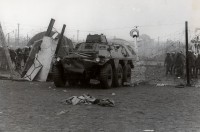
A Saracen vehicle breaching an inner wire fence in the Maze Prison Riots of 1974.
MAZE PRISON RIOT 1974
On 15 October 1974 Republican prisoners serving sentences in the Maze prison rioted. The Battalion was mobilised to deal with it, with tactical headquarters and two companies flying directly to the Maze from Ballykinler, while ‘D’ Company came by road from Aughnacloy in Saracen armoured personal carriers. This was not a spontaneous outbreak of violence by the inmates but a planned event, designed to coincide with other disturbances in Northern Ireland. The prisoners were well prepared for their action, they had erected barricades, stockpiled bricks and hunks of concrete, made various weapons such as poles with six inch nails embedded in their ends, improvised maces and pieces of beds with their ends made as jagged as possible. They even had respirators. A private soldier remembered 'I can’t remember the exact time we went in but it was light. The company entered the Maze and we went into what looked like a sports field. It was a single gate and as we got in we panned out into what could only be described as an extended line. I was a baton gunner as were many others. To say it was a turkey shoot is no exaggeration. ‘C’ Company were under extreme pressure and several soldiers were separated with their lives in immediate danger. ‘C’ company came under severe pressure until the timely intervention of a Squadron from the 3rd Royal Tank Regiment (3 RTR). Throughout the operation the troops on the ground were assisted by helicopters dropping CS gas on the rioters and in one instance on ‘D’ company. Eventually two Saracens pushed a hole through the wire fences and the whole force which by now had risen to seven companies, charged through the gaps in the fence and cornered the prisoners up against the wire at the edge of the football pitch. The battle was over. Many soldiers from the Battalion sustained minor injuries with thirteen going to Musgrove Hospital in Belfast for treatment. The inmates at the Maze were experienced men and as such operated under their own command structure inside the prison system. Prior to the disturbances the republican prisoners had a local truce with the loyalist prisoners enabling them to use some of their cell accommodation as a field hospital. After the battle was over the prisoners (there were over 400 of them) were lined up against the wire at the edge of the football pitch, and during the day were taken back to the various compounds. By 1800 hours that evening the Battalion had left the prison with the prisoners, now well and truly subdued, preparing to spend a cold night without shelter. And so ended one of the regiment’s most violent episodes to date. [The estimated cost of damage to the Maze Prison, during disturbances on 15 October 1974, was put at £1.5m.]
BOMBING AT SANDES SOLDIERS HOME 1974
On 28 October 1974 a massive IRA bomb exploded outside the Sandes Soldiers Home which was situated just outside the Ballykinler barracks. At the time it was full of soldiers on their morning break. The building caught fire and collapsed. Corporal Coughlan and Private Swanick were killed and thirty three others from the Battalion were injured, some badly. In addition two civilian members of staff also died. There were a number of reasons put forward for the attack on it by the IRA, - the Battalion’s involvement at the Maze prison riot, or revenge for the death of Paul Magorrian who was shot by members of the Battalion in August. In either case it mattered not, the Battalion continued with its task. The Home was later rebuilt and on a subsequent tour the Battalion erected a monument to the two soldiers who had lost their lives there.
SOUTH ARMAGH
The hectic pace continued and the bulk of the battalion took over the responsibility of South Armagh from 45 Commando, Royal Marines. Shortly after taking over a patrol led by Corporal Windsor was ambushed in the main square of Crossmaglen. They came under heavy fire and Corporal Windsor and Private Allen were killed with Private Walters being injured. C Company in Newry came under fire a number of times which together with bombings kept them stretched. They were later relieved by the 1st Battalion Royal Green Jackets who suffered thier first casulty when Rifleman Gibson on the advance party was shot dead. Even after deploying back to Ballykinler the battalion continued operations.
And so ended one of the Battalions busiest tours in the Province. Their next posting was to Shoeburyness.
1975 – 1976 - UNITED KINGDOM - SHOEBURYNESS
The Battalion formed up at the old Barracks, Shoeburyness in Essex on the 3rd February 1975. They were aware from the outset that they were going to carry out a further move to Warminster, mid 1976 so this posting was to some extent viewed as transitory. The Battalion initially carried out individual training. This was later intensified with Brigade exercises. This continued until the 30th August 1975 when the Battalion deployed to Cyprus.
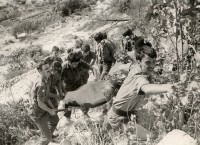
Drums Platoon recovering victims of a road traffic accident on the Troodos Mountain, Cyprus in 1975/76.
CYPRUS 1975
A six month emergency tour in Cyprus, based in Salamanca Barracks Episkopi, was the highlight of the next tour based at Shoeburyness in Essex. They were deployed between the two sovereign base areas. The Battalion task during this time was the operational task of preserving the internal security of the two bases, a role given added edge by the Turkish invasion of northern Cyprus in 1974. The second task was to undertake, as far as practicable, the initial training for the Battalion’s conversion to the mechanized role, which was in preparation for the tour starting in September 1976 as the School of Infantry’s Demonstration Battalion. The tour was quite uneventful with one incident of note. The Corps of Drums, led by Drum Major Coveney, with C/Sgt Hobbs as second in command, were stationed at Royal Air Force (RAF) Troodos as a rapid reaction force for the radar installation located nearby. In the autumn of 1975 they came across the result of a Ford Anglia failing to navigate a very sharp bend. As a result of this incident C/Sgt Hobbs was awarded the General Officer Commanding Cyprus’s personal commendation for Meritorious Service. It read 'On 22nd September 1975 the Corps of Drums, 1st Battalion, the Duke of Edinburgh's Royal Regiment were returning to Episkopi from Troodos after a tour of duty. The platoon was commanded by Col Sgt. Hobbs. Ahead of them a car drove off the road and plunged five hundred feet to the valley below. The car contained three passengers, a man and a woman, and a child. Led by C/Sgt. Hobbs, the Corps of Drums climbed down the cliff face to give aid. They found that the two adults had been killed and the child so severely injured that she died soon after the accident. C/Sgt. Hobbs immediately organised the recovery of the bodies which had to be carried up the hill to a waiting ambulance.. Throughout the operation, which was both difficult and of necessity carried out in a dignified manner, his conduct, leadership and determination were of the highest order, and his coolness and humanity made a profound impression upon the crowd who witnessed the incident. C/Sgt. Hobbs and the men of the Corps of Drums acted in the highest tradition of the British Army, and brought great credit to the regiment, Near East Land Forces, and the Army'.
The Battalion returned to England in January 1976 and in March of that year received a visit from the Colonel-in-Chief, HRH the Prince Phillip. Further training with emphasis placed on shooting followed and in the Summer of 1976 they moved to Warminster and one of their home counties, Wiltshire.
1976-1978 - UNITED KINGDOM - WARMINSTER
On 25th August 1976 the Battalion occupied Battlesbury Barracks, Warminster, Wiltshire taking over from the Royal Irish Rangers as the demonstration Battalion for the school of Infantry and British Army. The Support Company was detached to Netheravon. In addition the Battalion maintained the demonstration platoon at the school of infantry establishment in Brecon. During this time the Battalion was directly involved with the introduction into service of a completely new weapon system They were equipped with the MILAN (the abbreviation for ‘missle leger anti-char’) , an anti tank guided missile introduced into service to replace the wombat 120mm recoilless anti-tank gun. The Battalion spent the next two years carrying out all aspects of Infantry drills, the only distraction came when the firemen went on strike.
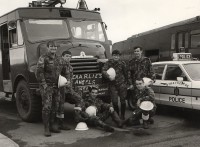
Firefighting in Scotland with Green Goddesses in December 1977.
FIREMAN’S STRIKE 1977
The final months of 1977 saw an ever worsening situation in the fireman’s union dispute with the government of pay and conditions of service. As a result the Battalion were deployed on Operation BURBERRY, which brought about the only semi- operational commitment by the Battalion during its tour of duty at Warminster. In December ‘A’ and ‘B’ Companies were ordered to deploy to Scotland and carry out fire-fighting duties. ‘A’ Company went to Glasgow and Lanark, and ‘B’ Company went to Greenock, Kilburnie and Preswick. 'B’ Company remained there for five weeks tackling ninety four fires. On every call-out each team would be accompanied by a patrol car from the Strathclyde police. Soldiers from the detachment at Queenslie tackled major rooftop blaze in Glasgow which tested them to the limit. In the first twelve days of operations they turned out to 68 alarms, resulting in 40 fires having to be extinguished. False alarms with good intent amounted to seven, and there were nine hoaxes. This was a good experience for the young soldiers, even allowing for potential local violence such as the threat offered to one of the teams after extinguishing a fire at a house when a young boy said 'Which team do you support Rangers or Celtic? Tell me or I'll bash you'. Because of this deployment the Ferozeshah parade was cancelled and the Colonel-in-Chief, HRH the Prince Phillip who was due to take the salute instead visited the companies in Glasgow. In January 1978 both the companies returned to Wiltshire. On the 2nd August 1979 the Battalion handed over its responsibilities to the Infantry Demonstration Battalion, which assumed responsibility for all of the School of Infantry commitments.
The Regiments next posting was to be in Osnabruck, West Germany as one of the twelve mechanized infantry Battalions then within the organization of the 1st British Corps.
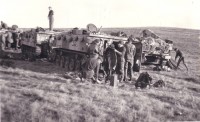
Troops having a 'Wash and brush-up' on Exercise 'Medicine Man' at Suffield in Canada in 1979.
1978 – 1983 - West Germany - Osnabruck
The Battalion moved to Osnabruck in August 1978 taking up its role as a mechanized Battalion with the 12th Armoured Brigade of the 2nd Armoured Division. They were based at Mercer Barracks and grouped with the 5th Royal Inniskilling Dragoon Guards. Once in place they embarked on an extensive training programme in order to get into shape as a NATO roled unit. Training took place at Bergen-Hohne, Sennelager, Haltern, Munsterlager, and Vogelsang, with more advanced training taking place in Canada on Exercise MEDICINE MAN. Whilst in Osnabruck the Battalion twice went to the Suffield training area in Alberta Canada, with ‘A’ company visiting for a third time. They were not immune to the events in Northern Ireland and they were later deployed once again to Londonderry. They took part in major exercises such as CRUSADER 80 and QUARTER FINAL.
LONDONDERRY 1979
On the 9th July 1979 the Battalion took over the responsibility for the area west of the Foyle area of Londonderry. They took over at 10.00 hours and by 1400 hours they were involved in their first incident. A small patrol from ‘A’ Company came under fire, and in the ensuing follow up operation a rifle and ammunition were recovered. The following day two bombs and a pistol were recovered nearby. The main feature of this tour was riot control with all the rifle companies experiencing various levels of ‘aggro’. The 9th, 10th and 11th August, the marching season saw them constantly dealing with problems of this type. Several marches happened at the same time, the ‘Troops out’ and ‘Apprentice Boys march’ were two such events. The tour involved all the normal tactics of a Northern Ireland tour, with Vehicle check points to be manned, observations points and patrolling both day and night. On the 8th November the Battalion handed over its area of responsibility to the 3rd Battalion the Royal Regiment of Fusiliers. On their return from Northern Ireland the Battalion set about honing its mechanized infantry skills. They were fortunate in as much as many of the senior NCOs had served in Minden ten years before in the same role.
BRUSSELS BOMB –1979
Whilst the Battalion were in Northern Ireland the band in addition to carrying out some rear party duties were also very active in carrying out band engagements. One such engagement was in Brussels where they were involved in a major IRA terrorist bombing incident in the Grande Place. On that occasion the stage on which they had been performing was bombed, causing a number of casualties and the loss of most of the bands instruments, which were destroyed by the explosion. Two bandsmen and eleven tourists were wounded. Within minutes of the blast the Mayor of Brussels, Pierre Halterman, received a call from the IRA claiming responsibility. To the particular credit of all the regimental bandsmen, the recovered quickly from that attack and continued their programme of engagements without a break.
The Battalion returned to England in January 1983 where they were to be based at Canterbury. Before they arrived they were aware that another tour of Northern Ireland was planned.
1983 – 1985 - United Kingdom – Canterbury
Following its lengthy period in Germany the Battalion returned to the United Kingdom, this time to Canterbury. From Canterbury it conducted operational tours to Northern Ireland and in Cyprus with the United Nations Forces and later carried out Public Duties in London. In 1984 the Battalion was presented with new Colours by the Colonel-in-Chief. The old colours were cased and laid up in a chapel in Salisbury Cathedral. The new, and final, set of colours have also been cased and are now on display at the Regimental Museum at the Wardrobe. The presentation of colours was followed by another exercise in Canada, at Wainwright.
From Canterbury the Battalion moved to Northern Ireland for another tour. Prior to leaving for the Province they held a service in Canterbury cathedral on the 27th May. As the Regiment did not have the Freedom of the City it was unable to march to the service with its colours flying and the Regimental Band leading. However, it did march to the service in column of route with its four companies, each 100 strong, and the drum major and front rank side drummers of the Corps of Drums to keep the pace and step.
NORTHERN IRELAND 1983
The main body moved to South Armagh on 4th and 6th June and the Battalion assumed command of the operational area from 40 Commando Royal Marines. Patrols were put on the ground as soon as they arrived. Within the operational area two companies were deployed well to the south, relatively close to the border between Northern Ireland and the Irish Republic. One Company operated out of Crossmaglen (XMG), with another based on the outskirts of Forkhill. ‘C’ Company provided the Battalions airborne reaction force and as a result got involved in most of the incidents that happened. ‘D’ Company was based at Bessbrook Mill, operating in the Newtownhamilton and Newry areas. The incidents were many and varied, bombs, shootings the capture of terrorists, and being on the wrong end of IRA mortars. The Battalion was heavily involved in operations to the last day of the tour, and had to conduct the handover of the operational area to the 1st Battalion Grenadier Guards while carrying out a wide-spread operation in response to a mass escape of prisoners from the Maze prison. Even as the incoming unit commanders were taking over specific tasks within the bases and elsewhere so the Battalion patrols in blocking positions on the main routes from Northern Ireland to Eire were subjected to sniper fire from terrorist gunmen. By the 5th October they were back in Howe Barracks. This tour was notable because of the lack of any serious casualties sustained.
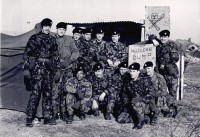
10 Platoon at Greenham Common, Berkshire, November 1983.
In the mid 1980s controversial (nuclear) Cruise Missiles were delivered to the United States Air Force (USAF) base at RAF Greenham Common, Berkshire. The Battalion, which had been at Howe.
GREENHAM COMMON 1983
Barracks, Canterbury, Kent, since 1983, were deployed to the base on the 11th November 1983 to secure it from incursions by several peace movements, especially the 'Peace Women'. The police were responsible for dealing with the demonstrators outside the fence but because of the length of the perimeter it was necessary to draft in troops to assist with the building of substantial wire fencing and watchtowers, and to also patrol them. The conditions were somewhat Spartan but the troops soon adapted and made the best of it. The tour was fairly tedious and uncomfortable, carried out from tented accommodation in bitterly cold weather. During its several weeks at the airbase the Battalion constructed one of the longest barbed wire fences most of the soldiers had ever seen. A further deployment took place in February when Battalion Headquarters (Bn HQ) and two companies again deployed to man the wire.
PRESENTATION OF NEW COLOURS 1984
Shortly before the duty at Buckingham Palace, Field Marshal his Royal Highness The Prince Philip, Duke of Edinburgh, the Colonel-in-Chief, presented new Colours to the regiment at Howe Barracks, Canterbury, on 8 June 1984. The previous stand of Colours had been presented by him in 1959 on the formation of the regiment. The officers receiving the Colours were Second Lieutenants White and Dennis. The escorts for the new Colour's were WO 2 Bryant; Colour Sergeants North and McLeod. An old soldier who witnessed the parade and who had taken part in many parades in the past said 'It was a brilliant parade, the lads were very steady and a credit to the regiment. I don't know what it is, but when the Colours appear on parade, with the Battle Honours displayed it gives you real pride'. These Colours were carried until 1994 when they were laid up in the regimental museum after the amalgamation with the Gloucestershire Regiment.
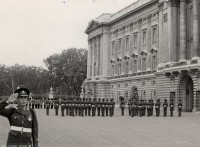

Public Duties 1984.
PUBLIC DUTIES 1984
In October 1984 the regiment was given the honour of mounting guard at Buckingham Palace. A company of 150 soldiers together with the Band and Corps of Drums under the command of Major Lake went to London for a three week commitment. In addition to guarding the Palace they mounted guards at the Tower of London and St. James's Palace. The commanding officer Lieutenant Colonel Mackereth, who commanded one of the guards, later remembered 'It was a great feeling marching down the Mall behind one's own regimental band's superb music'.
CYPRUS 1984 (UN TOUR)
The Battalion went to Cyprus in December 1984 for a United Nations tour, remaining for six months. The Battalion was split between two locations for the tour. Two companies and Battalion headquarters found themselves deployed to the west of Nicosia, while the other two companies were located in the Eastern Sovereign Base Area at Dhekelia. The main function was to ‘Man the Line’ as it was called, requiring the Battalion to man and operate some twenty observation posts on behalf of the UN. This meant observing and reporting on the Greek Cypriot and Turkish positions and activity across a narrow strip of land some twenty miles in length. The companies based at Dhekelia had the additional task of looking after the enclave of Ayios Nikolaos. This area was always a potential flash-point, as the Greek and Turkish communities there lived in very close proximity to each other. Towards the end of the deployment a representative group from the Battalion were presented with their United Nations medals. The medals were presented by the Force Commander Major General Greindl, an Austrian. During the parade the Battalion performed an immaculate feu de joie accompanied by verses of 'The Farmer's Boy' between the ripples of rifle fire. The Battalion returned to England in June.
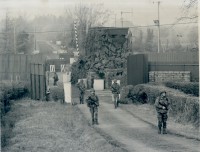
'A' Company patrol at Rosscor Bridge, Rosscor, Northern Ireland around 1986.
1985 – 1988 - NORTHERN IRELAND
The Battalion returned to the province in November 1985, being stationed at Alexander Barracks, Aldergrove. Its arrival coincided with a new IRA campaign against RUC police stations near to the border and the overall operational situation that greeted the Battalion was somewhat worse than had been expected. Although the first two months were quiet but Battalions activity was not. During December the Battalion had detachments as far dispersed as Dungannon and Belfast. In December despite the small contingent available the Battle of Ferozeshah was commemorated in the normal way with the colours being deposited with the WO and Sergeants. Mess. The Battalion itself came under a terrorist mortar attack at Dungannon in January 1986 when Company Headquarters received a direct hit from a number of mortar rounds. Four members of ‘A’ Company tried to take cover under one bed. There were no serious casualties although a number of men were buried under rubble and rendered unconscious. With Easter came the start of the ‘marching season’ which enabled the Battalion to deploy as a single entity for the first time to Belfast during the tour. During 1986 the companies from the Battalion made substantial finds of vehicle borne bombs, weapons and explosives. During its first twelve months in the Province companies and platoons of the Battalion deployed to some fifty different locations, earning the title ‘rent-a-troop’. Despite all this training continued and sporting activity was maintained. This pace of life continued into 1987 until mortar attacks were resumed on Battalion locations at Kinawley on the 19th March and on the 12th April at Belcoo. Further attacks followed with continuous deployment. Between July and September the Battalion was re-equipped with the Army’s new personal weapon, The Small Arm 80 (or 'SA 80'), which fired a 5.56 millimetre round and was fitted with an optical sight. On Sunday 8th November ‘B’ Company were in Enniskillen when the IRA detonated a huge bomb alongside the war memorial, just minutes before the annual remembrance parade. Eleven civilians were killed and hundreds injured. The company assisted as much as possible both during the day and the days that followed. At the end of 1987 the Battalion went on leave to prepare for the move to Hong Kong.
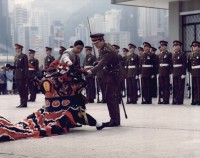
Commanding Officer, Lieutenant ColonelS W J Saunders, dotting the eyes of the dragon on the Battalion's official arrival in Hong Kong in 1988.
1988 – 1990 Hong Kong
The Battalion arrived in Hong Kong in January 1988, following in the footsteps of their forebears, both of which had served with distinction in China. The 49th Foot served in the First Opium War in 1841 which ended in the treaty of Nanking in which Hong Kong was formally ceded to the British. The China Dragon worn by the Royal Berkshires and later 1 DERR was a result of this campaign. Twenty years later the 99th Foot was part of the Anglo-French force that marched on Pekin in 1860. After the First World War the 2nd Battalion Wiltshire Regiment spent three years in Hong Kong, returning in 1929 for a year in Shanghai. They in turn were followed in 1932 by the 1st Battalion who served on active service in Shanghai during the Chinese-Japanese conflict. After the 2nd World War the 1st Bn Wiltshire Regiment returned to Hong Kong garrisoning the colony, providing drafts for Korea and manning the border. The official ceremony to welcome the Battalion to the colony, February 1988. It included a traditional Chinese lion dance, at which the Commanding Officer Lieutenant Colonel S W J Saunders was asked to paint the eyes of the dragon, so giving it life for the dance, which in turn would bring good luck for the regiment. The guard of honour were still wearing No. 2 dress, and had yet to be issued with the hot weather uniform. Whilst in Hong Kong the Battalion was based at Stanley Fort having relieved the 2nd Battalion Coldstream Guards. On arrival in Hong Kong the Battalion took part in patrolling and manning observation posts on the Chinese border. Although most of their 'Cold War' activity to date had been against the ‘Iron Curtain’ and the threat posed by the Soviet bloc, the posting to the colony required the same skills overlooking what was referred to as the 'Bamboo Curtain'. Extensive experience from deployments in Northern Ireland meant that the operational requirements for this posting were well within the Battalion’s capabilities. Since 1979 when the Army took over responsibility for the border from the Royal Hong Kong Police, the resident infantry Battalions of the 48th Gurkha infantry brigade were committed on a rotational basis to provide security and to maintain the sovereignty and territorial integrity of Hong Kong along the thirty three mile long Sino Hong Kong border. The border ran through a mix of hills, jungle, villages and wet-lands in the new territories, and was unmistakably delineated by a high fence, border access road and a variety of other obstacles and control points. The two official crossing points were at Man Kam To and Lo Wu. The border commitment occurred three times a year for a period of six weeks in duration each time. The companies deployed for this task were based at Dills Camp (used by the 1st Bn Wiltshire Regiment in 1950). Three companies were deployed with one on standby. Their primary task was to catch illegal immigrants (Known as IIs) trying to escape from China to Hong Kong. Any captured would be handed over to the Royal Hong Kong Police for screening and possible repatriation to China. On one night alone ‘B’ Company captured fifty in one night at Pak Hok Chau and Sandy Spur. By June 1990 there were 35,000 immigrants (Vietnamese boat people) incarcerated in detention camps in Hong Kong awaiting processing. As a result the Battalion erected 400 tents on the Sek-Kong runway. Because it was the typhoon season they had to strike the camp a number of times. The camp was not secure with many inmates escaping. As a consequence the Battalion were required to provide a guard to safeguard MOD property. Every four weeks each company provided manpower for observation posts, patrolling the perimeter and setting up ambushes. The internal policing was left to the civil authorities. The regimental journal later recorded ‘Most of the soldiers found this a sobering and reflective experience, coming face to face with an international problem'.
KOREA 1989
Whilst the Battalion was stationed in Hong Kong it was required to provide an honour guard in Korea from 13 February 1989 for a period of ten weeks. This consisted of a platoon commander, a second in command, an admin sergeant and three sections of ten men. Based at Yong San Camp they were part of a US company, together with other units from the Philippines and Thailand. During this time they provided ceremonial guards and also tactical commitments such as guards, sentries and a quick reaction force. In May 1990 the second detachment provided two soldiers to accompany each of five coffins of returned American dead from the Korean War. This was the first such event since the end of that war. In 1989 the regiment provided guard of honour at the Glosters Memorial in Korea which commemorated the actions of the Gloucestershire Regiment at the Battle of Imjin. Although the British only had a token presence in Korea it was a real indication that the 'Cold War' in this area of the world was very much alive.
EXERCISES
When not involved in tasks such as Korea the Battalion managed to send companies and other groups to exercise in a number of exotic and exciting countries in the far east and pacific region. These included Brunei, Singapore, Australia, New Zealand and Malaysia. The regimental band also carried out a two week commitment in Japan. During 1989 each rifle company participated in an overseas exercise. ‘A’ company went to Sabah for exercise EASTERN TAMU for seven weeks. ‘B’ company went to the Malaysian mainland for exercise WESTERN TAMU.
The Battalion handed over in August 1990 and returned to England and a tour of duty in the 24 Airmobile Brigade in Catterick.
1990 – 1994 - United Kingdom – Catterick
The Battalion re-formed at Bourlon Barracks, Catterick and prepare for the Air-Mobile role. Cadres and courses had to be attended to prepare for not only the new role, but also for the next Northern Ireland tour.
NORTHERN IRELAND 1990
The Battalion deployed to County Fermanagh in Northern Ireland December 1990 and quickly settled into a routine of manning the many vehicle check points and patrolling the area. Its operation title for the tour was ‘The Fermanagh Roulement Battalion were responsible for ten PVCP’s throughout the area. ‘A’ company operated in an area known as Fermanagh west. It included over one hundred kilometres of border and forty-three recognized border crossing points. All manner of patrols were carried out in helicopters, vehicles, and boats. The static positions provided excellent targets for the IRA and a number came under attack. On the 11th February 1991 the Battalion was paid a visit by the Colonel –in-Chief HRH The Prince Phillip at St Angelo base. On the 15th February the IRA tried to shoot down one of the helicopters when it was preparing to extract on of the Battalions patrols. The firing point was across the border where 360 empty shell cases were recovered. The Battalion took part in a major operation on the 19th March, operation MUTILATE in which a number of border crossings were closed and the PVCPs at Derryard and Boa Island were removed. The next major attack on the Battalion took place on the 20th April at the Gortmullan PVCP which came under attack which was responded to with great vigour. For the first time in the troubles the .50 Browning heavy machine gun was brought into action. Teams came out from the base and skirmished towards the enemy, but by the time they got anywhere near the targets they had retreated over the border. This was the Battalion’s last action in which fire was exchanged. They returned to Catterick in May.
CERTAIN SHIELD 1991
The battalion returned to the mainland from Northern Ireland in May 1991 and started a period of intensive training for its formal conversion to the air mobile role. In order to achieve this the Battalion was reorganised with the number of platoons within the companies being cut to two, with one of these being equipped with MILAN anti-tank guided missile systems. The commander of the 24 Air Mobile Brigade expected the Battalion to be ready in all aspects in time for the Brigade Exercise CERTAIN SHIELD in September 1991. Hard training at all levels followed. In June the Battalion carried out its own exercise at Otterburn at the end of which the Battalion was competent to execute all of the basic fly-out procedures and was able to apply those procedures to tactical situations. All the hard work was successful with the Battalion deploying in September on Exercise CERTAIN SHIELD. The exercise took place in a large area of rolling countryside to the south of Paderborn, but the division’s initial concentration areas based in farms and villages some one hundred kilometres to the west and just to the south of the British and German garrison town of Munster. For the soldiers it was business as usual, apart from the mode of transport. They were still required to be able to carry back breaking loads, march at speed, and dig fast. At the end of the exercise the Battalion returned to Catterick by sea and air. The Battalion had met the requirement stated by Commander 24th Air Mobile Brigade in May for the Battalion to be in all respects operational as an air mobile infantry Battalion by September.
USA 1992
In 1992 the Battalion went to the United States for a four week exercise 'Trumpet Dance'. The objective of this exercise was 'to confirm the operational effectiveness of 1 DERR as an airmobile Battalion' The Battalion deployed to Washington State in the United States in March/April 1992 and were based at Fort Lewis. This exercise was the Battalion’s main training event in 1992 and it effectively concluded their conversion to the airmobile role due to the opportunity it offered to deploy and fire MILAN. This was the last overseas exercise carried out by the Regiment. The Battalion deployed 644 strong, including attachments. The exercise was based in three military training centres, Fort Lewis, Bonneville Camp and Yakima Firing Centre. All phases of Infantry skills were tested. Whilst the companies conducted their training the band carried out a series of engagements throughout Washington State. This culminated in a joint concert with the band of the 1st US Corps at the State Capitol. Olympia. In addition the Corps of Drums also participated in a major beating retreat at the 1st US Corps Anglo-American Band Concert.
SOUTH ARMAGH 1993
It was announced in early 1992 that the Battalion was to carry out a final operational tour in South Armagh from March to September 1993. In order to carry out this deployment the Battalion was reinforced by ‘A’ (Gallipoli) Company of the 2nd Battalion Princess of Wales’s Royal Regiment. The Battalion deployed to South Armagh on the 26th march 1993 with its headquarters based at Bessbrook mill and there they were further reinforced by a company from the 2nd Battalion Royal Regiment of Fusiliers, giving it a strength of six companies. The Battalion experience with helicopters proved to be a great advantage and they were used to dominate vehicle movement on the roads of South Armagh. Crossmaglen (XMG) was under the responsibility of ‘C;’ Company who found very little had changed since their last visit. There they came under two mortar attacks against the base and four shootings against the company with several soldiers being wounded. A number of raids were carried out and a number of heavy weapons were seized, in particular after an IRA attack on helicopters on the 23rd September. All the other companies had their own area of responsibility. A number of significant terrorist inspired incidents occurred during the Battalion’s time in South Armagh. These included a multi-weapon shoot against the Baruki observation Sanger in Crossmaglen on 25th March, a shooting incident on 3rd April which resulted in injuries and a multiple mortar attack against the base at Crossmaglen on 11th June. On the 26th June a patrol from ‘B’ Company suffered a fatal casualty near Newtonhamilton when Private John Randell was wounded and later died. The following month soldiers from ‘D’ company intercepted two vehicle borne bombs near the village of Whitecross. This was followed in Crossmaglen with another shooting which killed Lance Corporal Kevin Pullin. He was the last soldier of the regiment to be killed on operations.
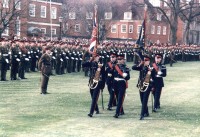
The Colours being marched off on the final parade of The Duke of Edinburgh's Royal Regiment in the Cathedral Close at Salisbury in April 1994.
On the Battalions return to England they had to move to a temporary camp at Wathgill on the Yorkshire dales. They remained at this location during the winter until they joined the Gloucestershire Regiment (28th/61st) in Alma Barracks to form the new Regiment. Joint courses were carried out with the Glosters and training was very much kept at a low level. At this time they had moved from the 24 Air Mobile Brigade to the 19th Mechanized Brigade where the training was aimed at conventional warfare and the use of the Saxon armoured personnel carriers. The final Ferozeshah parade took place on Tuesday 21st February 1993. the final act of farewell by the Battalion , and therefore the regiment also, was a series of eight freedom marches in Berkshire and Wiltshire during March. The final thanksgiving service was held at Salisbury Cathedral on the 25th March.
The Regiment ceased to exist on the 26th April 1994 and the new Regiment the Royal Gloucestershire, Berkshire and Wiltshire Regiment was formed the following day.